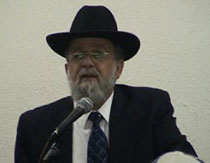Beit Midrash
- Sections
- Chemdat Yamim
- Bemare Habazak - Rabbis Questions
Answer: The Gemara in Pesachim (85b), in the context of eating Korban Pesach within a certain area, discusses whether those who are within the doorway of the border are considered inside or outside. The gemara says that the same is true for tefilla, i.e., tziruf (formation of a minyan). The gemara in Eruvin (92b), regarding a minyan split between adjacent courtyards of different sizes, distinguishes between different configurations. One might have argued that these sources are not referring to cases under one roof. However, it is clear from Rishonim, the Shulchan Aruch (Orach Chayim 55:19) and many poskim that the guidelines for separate rooms inside a building are much the same as those of separate courtyards.
The Rashba (Shut I:96) asks why it is allowed for a chazan to stand on the bima when its dimensions make it a separate domain, thus separating the chazan from the tzibbur. He gives two answers: 1. A bima specifically functions as an integral part of the shul; 2. If some people in one domain see some people in the other one, they constitute one unit (as they do regarding a zimun for bentching- Berachot 50a). The Shulchan Aruch (ibid.) cites the Rashba’s first answer as halacha regarding tziruf for a minyan, while citing an opinion that this is only on condition that the bima’s partitions do not reach the ceiling. These are among the many sources that debunk the claim you were told, as a bima is obviously under the same roof as the rest of the shul, and still other reasons are needed to explain the tziruf.
Most practical cases depend on the extent to which we accept the Rashba’s second answer – that a visual connection between the two groups suffices. (Another scenario, based on the details of the aforementioned gemara in Eruvin (see Shulchan Aruch ibid. 15), is rarely applicable. Those standing in the doorway probably do count (Mishna Berura 55:50), but that is not of much help.) The major question is whether the parameters for connecting groups regarding zimun (i.e., visual) apply to creating a minyan for tefilla. The Mishna Berura (55:48 & 55:52) is not conclusive on the matter. Therefore it is best, when possible, to have ten people in one room.
Once a minyan is achieved in one room, most opinions assume that those in the overflow room receive the benefits of a minyan, regardless of the visibility connection. The Radbaz (650) says that those in the small room are fully considered as davening with a minyan if the small room can be accessed only through the main room. In any case, those not in the room with the minyan may answer to those parts of tefilla that require a minyan (Shulchan Aruch, OC 55:20) and be exempted from obligations by those inside the main room (Mishna Berura 55:61). The logic is that the ten in one room create the setting (the shechina – see Mishna Berura 55:60) for the matter of kedusha, after which we say that partitions do not prevent the sanctity to flow (see ibid. and Pesachim 85b). (See further opinions in Piskei Teshuvot 55:27.)
It seems that the logic just mentioned allows for leniency in the following common scenario. Ten men are davening in the main room, but not enough of them have finished Shemoneh Esrei when the chazan would like to start. In Living the Halachic Process (I:A-10) we preferred the opinion that one needs eight people, not including the chazan, to answer. Some poskim required fewer because the presence of the ten brings the shechina, but others counter that chazarat hashatz requires a minyan who relate to the repetition. In the case of adjacent rooms, we can combine factors. The presence of ten in the big room brings the shechina. Then, we only need ten people who are connected to chazarat hashatz. Since those in the small room can fulfill their obligation through the chazan, they count toward the quorum needed to start.

Bemare Habazak - Rabbis Questions (627)
Various Rabbis
60 - Delay Between Birkat Kohanim
61 - A Minyan Split Between Adjacent Rooms
62 - Al Ha’eitz Eaten a Variety of Fruits
Load More

Ask the Rabbi: Sacrificing Davening to be the Tenth Man
Rabbi Daniel Mann | Sivan 5785

Ask the Rabbi: What May One Do before Havdala after Yom Kippur?
Rabbi Daniel Mann | Tishrei 5786

Ask the Rabbi: Erev Pesach That Falls on Shabbat
Rabbi Daniel Mann | Nisan 5785

























